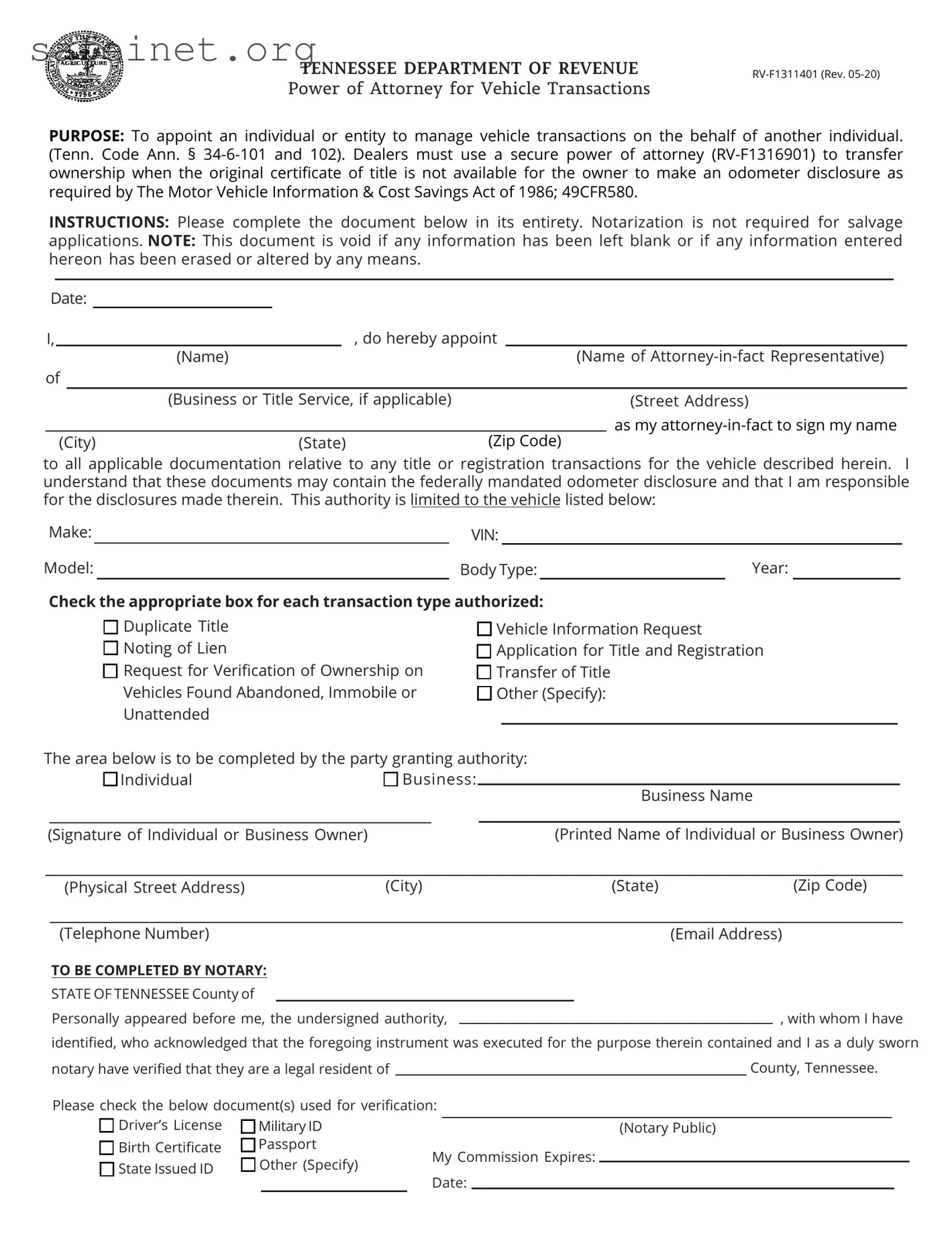The Vehicle Power of Attorney (POA) form, RV-F1311401, shares similarities with the Durable Power of Attorney (DPOA). Both documents grant one individual the authority to act on behalf of another in specific matters. However, the DPOA is broader in scope, allowing the agent to manage financial and legal affairs even if the principal becomes incapacitated. In both cases, clear designations of authority are essential to ensure that the appointed agent can perform necessary tasks effectively.
Another comparable document is the Financial Power of Attorney (FPOA). Like the Vehicle POA, the FPOA specifically designates someone to manage financial decisions for the principal. Both forms require the principal to be of sound mind when signing, and each allows the agent to handle transactions such as managing bank accounts and investments. The distinction lies in the FPOA's comprehensive nature, covering a wider array of financial responsibilities beyond just vehicle matters.
The Medical Power of Attorney (MPOA) also bears resemblance to the Vehicle POA in that it entrusts decision-making authority to an agent, but it pertains specifically to healthcare choices. In scenarios where a principal is unable to communicate their medical wishes, the MPOA empowers the designated agent to make informed decisions. Despite differing content focus, both documents necessitate informed consent and clarity regarding the scope of authority granted.
One further document similar to the Vehicle POA is the Limited Power of Attorney (LPOA). This type of document grants an agent specific, limited powers rather than the full range of authority. Just like the Vehicle POA, which may only include tasks like signing titles or transferring ownership, the LPOA is used for defined tasks within a particular timeframe or for a specific transaction. Both documents emphasize specificity in the powers granted to avoid any overreach by the agent.
The Assignment of Authority form is another related document. While it typically covers specific rights and obligations, it can serve a similar purpose to the Vehicle POA by enabling one individual to delegate certain responsibilities or rights regarding vehicle ownership. The key difference lies in the nature of the assignment; the Assignment of Authority often applies to contractual rights and duties beyond just vehicle management.
The Consent for Transfer form is akin to the Vehicle POA as it facilitates the transfer of vehicle title or registration by allowing another person to act on the owner's behalf. Much like the Vehicle POA, this form requires the owner's consent and a clear understanding of the transfer process. However, its use is typically limited to the transfer aspect, whereas the Vehicle POA may encompass broader actions related to vehicle ownership.
The Rental Power of Attorney is also a relevant comparison. This document provides authority to an agent to manage rental agreements and property-related decisions. While it focuses on real estate rather than vehicles, both forms enable agents to perform specific tasks specified by the principal. The essence of grantor trust remains, as both require careful delineation of the powers bestowed upon the agent.
The Business Power of Attorney parallels the Vehicle POA in that it allows an agent to make business-related decisions on behalf of another. Similar to its vehicle counterpart, it requires explicit language detailing the extent of authority granted. This document would typically cover responsibilities related to business operations, where the Vehicle POA focuses exclusively on automobile-related transactions.
Finally, the Living Trust document can be compared to the Vehicle POA in some respects, as it allows a trustee to manage assets for the benefit of beneficiaries. Both documents create a relationship between a principal and an agent or trustee, emphasizing the management of property—vehicles in the case of the Vehicle POA. While the creation of a living trust encompasses a wider range of assets and provides a framework for asset distribution upon death, the management concept remains a shared element.

